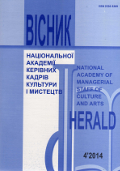МИСТЕЦТВО "ЗВІРИНОГО СТИЛЮ" – ОСНОВНЕ ВІЗУАЛЬНЕ МИСТЕЦТВО СКІФСЬКОГО НАРОДУ
The art of "animal stile" is the main visual art of scythian people
Author(s): Bogdan VidmaSubject(s): Archaeology, Visual Arts, Aesthetics, Ethnohistory, Ancient World, Cultural Anthropology / Ethnology
Published by: Національна академія керівних кадрів культури і мистецтв
Keywords: Scythian art of "animal style"; the organic element of Scythian culture; the way of visual reflection and safekeeping of Scythian worldview; special position of Scythian applied art under condition of
Summary/Abstract: In the article author touches upon the themes of nascence and functioning of Scythian "animal stile" art in the society of steppe nomads. Considering the Scythians as a part of Indo-Iranian population author explores the possible foundation of the Scythian art which transparently should be outstreaming from the earliest Indo-Iranian mythological opinions. Leaning to the scientific views of Elena Kuzmina who was specifically insisted on prevalence in Scythian ideology, the elements of ancient Indo-Iranian mythological outlook the author directs the reconnaissance to the point of unique position of Scythian "animal stile" art in the nomads' community. The author examines the applied art of the Scythians as the single visual art of steppe nomads. It is known that the Scythians did not have a monumental architecture, large sculpture and visually reflected their views only in folk art of "animal style". Based on these facts, the author suggests that the applied art of the Scythians has taken on itself some functions which in other cultures are belonged to the monumental art. Culture is an integrative system and its elements are inclined to be adapted to each other. So the applied art was a perfect component which was able to integrate to culture of Scythians. Apart from this the art of "animal style" has served to realization of important needs of the Scythian folk. It was represented by itself the inseparable unity of aesthetic, social and religious aspects. Social aspect was displayed particularly in fact that the art of Scythian "animal style" was closely related with society of warriors and was in a certain sense the identification sign of the Scythian warriors caste. Religious (or mythological) aspect disclosing by the fact that "animal style" was broadcasted the important mythological information of the Scythian folk being a way of visual reflection and safekeeping of Scythian worldview. The aesthetic aspect was equally important (even though there is a indivisible phenomenon) and was manifested in perfect decorative characteristics of steppe nomads' applied art.In the research the author in many ways relies on conceptions of Dmitry Raevsky. Particularly the author adopts the idea that the culture of Scythians' ancestors was deprived from visual art and in return therein was significantly developed the verbal creativity and probably music and singing. In the course of their existence at a certain point the Scythians created their own visual art by the method of borrowing and reinterpretation of specific images. Via these recycled images the Scythians visually expressed the main conceptions of their outlook which started at a certain stage to require such expression. The cause of it could be the military campaigns of the Scythians to the Southwest Asia. In the author's opinion these ideas are well combined with Elena Kuzmina’s views about ancient Indo-Iranian origins of mythological conceptions of the Scythians.In this manner basing on Elena Kuzmina’s views and accepting ideas of Dmitry Raevsky the author emphasizes the unique position of "animal style" applied art in the Scythian society. But at the same time from our side we underline on the fact that the Scythian art of "animal style" was approximately the only visual art of folk of the Scythians (without taking into account the stone steles on Scythian burial mounds). Based on this observation the author makes the suggestion that in the Scythians' society their folk applied art should have been implementing in addition some of those functions which in certain others cultures were ensured by other types of art (especially by monumental sculpture and sacral architecture).Among the inhabitants who lived sedentary (such as urban citizens of ancient towns) monumental art has al-ways had the duty of visualization of significant religious and social concepts, implementation of socially important ideals; it was intended to perform certain functions of commonwealth such as to promote among the population the ideas and convictions which should unite the citizens and inspires the faith in greatness and power of the state and the ruler (and in ancient societies it also shows a higher power, the divine ascendancy, alderman of which the ruler was). In our opinion the Scythian art of "animal style" likewise was directed to unite the community of the Scythian warriors (being the hall-mark of them), it was broadcasted important information of mythological and social (ideological) value, and it was also a utterance of Scythian nationhood by transferring of mythological foundations of social structure (for example: three-level model of the world – three brothers-founders of Scythian people – three Scythian kingdoms) and by expression of authority of the ruler by the magnificence.
Journal: Вісник Національної академії керівних кадрів культури і мистецтв
- Issue Year: 2014
- Issue No: 4
- Page Range: 108-111
- Page Count: 4
- Language: Ukrainian

